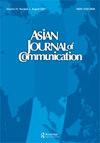Media freedom in Asia: challenges from below
IF 1.5
2区 文学
Q2 COMMUNICATION
引用次数: 2
Abstract
ABSTRACT The scholarship on media freedom has tended to focus on threats from state and corporate power, avoiding the awkward reality that ‘people power’ can also be a source of constraints. These ground forces can work in tandem with political and economic power, or independently. They contradict the common assumption that the public is the natural ally of independent media, against the tyranny of states and markets. While Asian publics are more able than ever before to make themselves heard, it is naive to believe that they will always use their rising voices in support of democratic values. Apathetic silence is common, especially when people do not identify with the victims of human rights abuses, or when they do not feel directly harmed by official corruption. Today, there is ample evidence that the glare of publicity does not guarantee justice. In highly polarised societies, public opinion can even turn against journalists and other critics who malign leaders, parties and movements that are seen to represent the masses. Such dynamics require closer attention to what it means for the media to be free from power, and whom exactly the media should use their freedom for.亚洲的媒体自由:来自底层的挑战
摘要关于媒体自由的学术倾向于关注来自国家和企业权力的威胁,避免了“人民权力”也是制约因素的尴尬现实。这些地面部队可以与政治和经济力量协同工作,也可以独立工作。它们与公众是独立媒体的天然盟友、反对国家和市场暴政的普遍假设相矛盾。虽然亚洲公众比以往任何时候都更有能力让自己的声音被听到,但相信他们会一直用自己不断上升的声音来支持民主价值观是天真的。冷漠的沉默是常见的,尤其是当人们不认同侵犯人权的受害者,或者他们不觉得受到官员腐败的直接伤害时。今天,有充分的证据表明,公众的关注并不能保证正义。在两极分化严重的社会中,公众舆论甚至会转而反对记者和其他批评者,他们诽谤被视为代表群众的领导人、政党和运动。这种动态需要更密切地关注媒体摆脱权力意味着什么,以及媒体到底应该为谁使用他们的自由。
本文章由计算机程序翻译,如有差异,请以英文原文为准。
求助全文
约1分钟内获得全文
求助全文
来源期刊

Asian Journal of Communication
COMMUNICATION-
CiteScore
3.70
自引率
0.00%
发文量
38
期刊介绍:
Launched in 1990, Asian Journal of Communication (AJC) is a refereed international publication that provides a venue for high-quality communication scholarship with an Asian focus and perspectives from the region. We aim to highlight research on the systems and processes of communication in the Asia-Pacific region and among Asian communities around the world to a wide international audience. It publishes articles that report empirical studies, develop communication theory, and enhance research methodology. AJC is accepted by and listed in the Social Science Citation Index (SSCI) published by Clarivate Analytics. The journal is housed editorially at the Wee Kim Wee School of Communication and Information at Nanyang Technological University in Singapore, jointly with the Asian Media Information and Communication Centre (AMIC).
 求助内容:
求助内容: 应助结果提醒方式:
应助结果提醒方式:


